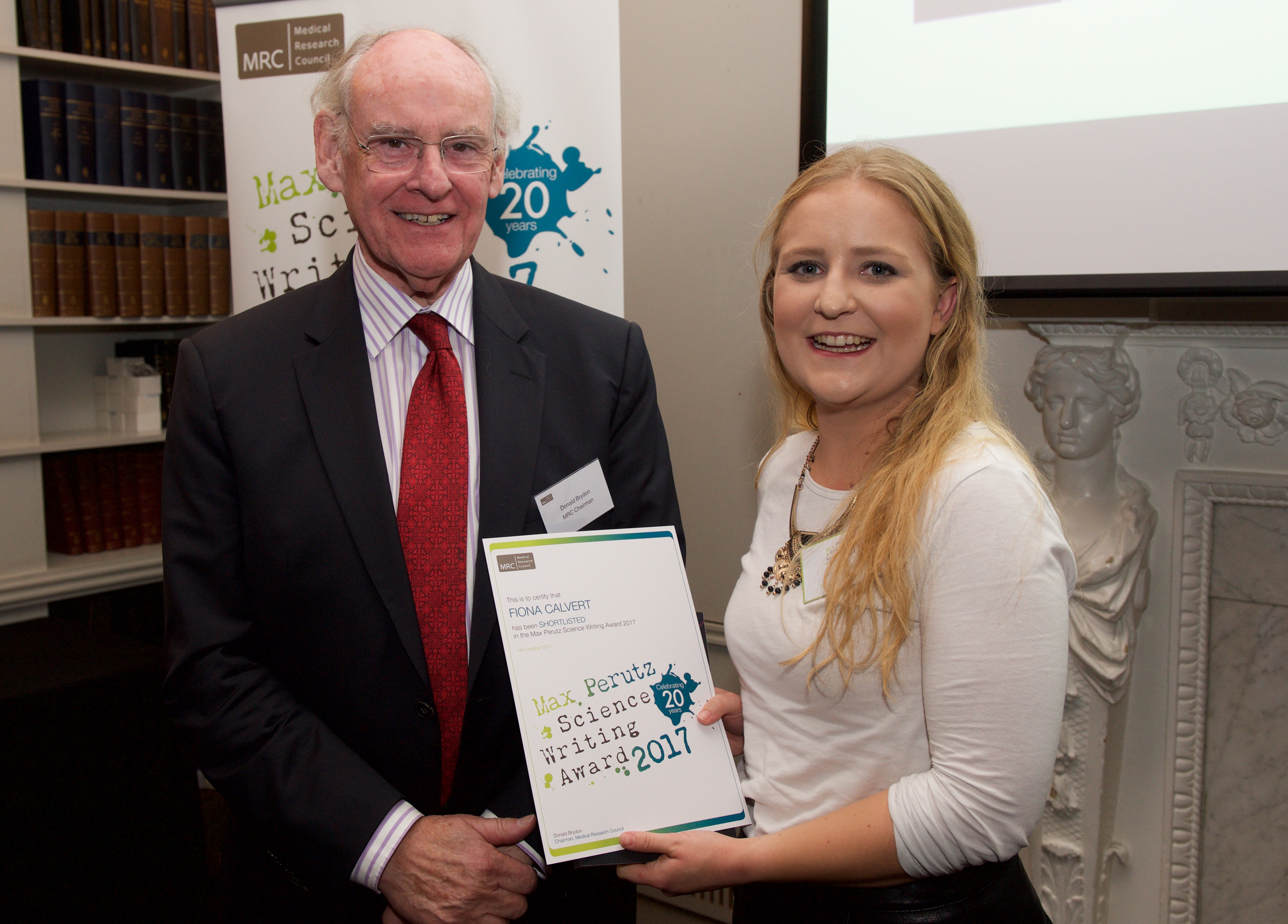
By: Fiona Calvert
Date: 13.11.17

MRC Chairman Donald Brydon CBE and Fiona Calvert at the MRC Max Perutz Science Writing Awards 2017. Photo credit: MRC
This article was shortlisted for the MRC Max Perutz Science Writing Awards 2017.
“But Alzheimer’s is me, unwinding, losing trust in myself, a butt of my own jokes and on bad days capable of playing hunt the slipper by myself and losing. You can’t battle it, you can’t be a plucky “survivor”. It steals you from yourself.” – Terry Pratchett 2008.
Author Terry Pratchett, who was diagnosed with a form of Alzheimer’s disease in 2007, worked tirelessly until his death to beautifully articulate what living with dementia was like for him. Not just the memory loss, but also the loss of independence, personality, of your ability to maintain relationships and ultimately the loss of yourself. He gave people robbed of their memories, and themselves, a voice.
Dementia is estimated to affect 46.8 million people worldwide, with the number predicted to double every twenty years. In 2015 there were nearly 10 million new dementia cases, that’s one new diagnosis every three seconds. Alzheimer’s disease is the most prevalent form of dementia but it’s about more than just facts and figures: it’s about the people whose lives it steals.
Any diagnosis can be daunting for a patient, but a diagnosis coupled with no effective treatment, let alone a cure, is terrifying. Terry Pratchett used his voice in the best way, to fight for more exposure and to fight for a cure. As a scientific community it is our responsibility to take up that fight. In order for effective treatments to reach patients we have to understand the disease we’re fighting. My PhD will hopefully help to do just that.
At the Sanger Institute, where my PhD is based, we are fascinated by all things genetics, which may seem a long way from a patient suffering from Alzheimer’s disease. Yet we know that certain gene mutations (a small error in a gene) can increase your risk of getting Alzheimer’s disease and now we are working to understand how and why that is.
Creating a list of Alzheimer’s disease risk mutations is like having all the edge pieces of a puzzle put together – it doesn’t show us the full picture but it creates a guideline that makes filling in the middle a little bit easier. The puzzle of Alzheimer’s is huge and so, although the hope is that one day we will see the full picture, today, I’m looking at just one corner.
The edge I spend my days looking at, trying to understand how the puzzle pieces fit, is the part that involves your immune system. The same immune system that helps you fight off a cold plays a vital role in Alzheimer’s disease. We didn’t really know this until we found the edge pieces of our puzzle - that list of gene mutations that increase your risk of getting Alzheimer’s disease includes some that affect your immune system.
So we have the edge of our puzzle, but what next? I’m taking those small errors in genes and looking at how they affect your brain’s specialised immune system. This is where, for me, the science gets really cool and it’s the part of my day-to-day that reminds me why I am so fascinated by science.
Until recently, studying the brain’s immune system was nigh on impossible – these cells are not exactly accessible. However, we hope that a new form of stem cell, induced pluripotent stem cells, are going to change that. These cells are incredible: they have the potential to turn into any other cell in the body and all we need to create them is a tiny skin sample. Then with a bit of reprogramming (and a lot of patience), we can turn that sample into stem cells.

Microscope images of induced pluripotent stem cells (left) and (right) after 20 days of development into cells that are similar to microglia.
I’m taking these stem cells, that have the specific gene errors from our list, and turning them into microglia. Microglia are an integral part of your brain’s immune system. They act like scavengers, hunting for things that definitely don’t belong, ingesting and destroying them. Being able to make these cells in a lab means that we can finally understand their role in Alzheimer’s disease (something that is currently very unclear) and how those genes from our list can change their behaviour.
Sometimes my days are spent so focused on my small corner of the Alzheimer’s disease puzzle, it is easy to forget why we are doing this in the first place. Every day people across the world suffering from Alzheimer’s disease lose that little piece of their memory, that little piece of themselves.
I am proud to work on a small corner of this much larger puzzle, in the hope that one day soon we’ll be able to pull all our small corners together. I am proud to be part of the fight, the fight that gives patients hope that one day they may be “plucky survivors”.
About the Author:
Fiona Calvert is a PhD student at the Wellcome Trust Sanger Institute in the group of Daniel Gaffney. She is studying the how genetic changes affect the brain’s immune response, focusing on developing a stem cell model for inflammation of neurons.
- This article was shortlisted for the MRC Max Perutz Science Writing Award 2017. It can also be seen with the other shortlisted articles here: https://www.mrc.ac.uk/documents/pdf/max-p-articles-2017/
Links:
- Genomics of Gene Regulation Group at the Sanger Institute: http://www.sanger.ac.uk/science/groups/gaffney-group
- Daniel Gaffney’s website: http://www.sanger.ac.uk/people/directory/gaffney-daniel
- MRC Max Perutz Science Writing Award 2017: https://www.mrc.ac.uk/skills-careers/studentships/for-current-mrc-students/max-perutz-science-writing-award/






